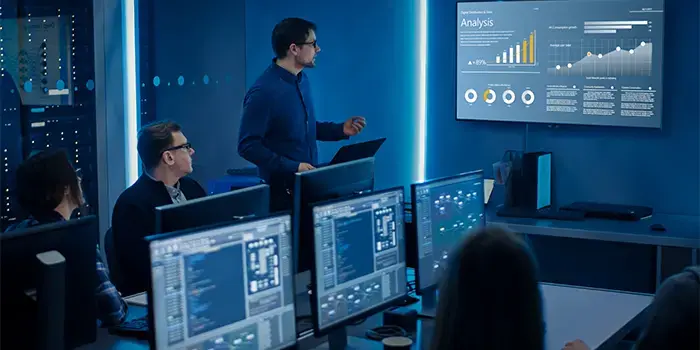Table of Content
TABLE OF CONTENTS

Overview
Graph technology promotes the evolution of Artificial Intelligence (AI). It interlinks data and defines relationships to model real-world complex and dynamic links between entities. It is an excellent tool for inferring relationships and empowers AI by presenting context. In the enterprise ecosystem, it is imperative to recognize that the data framework supporting AI holds equal significance as the outputs it generates. Therefore, incorporating the data used and produced by AI services becomes essential when making crucial decisions regarding AI. Also, a comprehensive understanding and integration of the data ecosystem are imperative to ensure optimal outcomes and maximize the value derived from AI initiatives.
Knowledge graphs: Providing context to AI for decisions
Knowledge graphs provide a means to streamline workflows, automate responses, and expand AI intelligent decision-making capabilities. Knowledge graphs encompass interconnected sets of facts that describe real-world entities, objects, or attributes and their interrelations that are understandable to humans. Mastech InfoTrellis empowers organizations with comprehensive knowledge graph intelligence, representing multidimensional business objects. By harnessing the power of knowledge graphs, our data experts unveil the intricate networks, correlations, relationships, and patterns within enterprise data. These insights drive favorable business outcomes, enabling informed decisions and unlocking new opportunities for success.
How does a knowledge graph work?
- Based on the graph: Knowledge graphs are structured using a graph data model, which allows for the representation of complex relationships between entities and concepts. It enables them to capture rich contextual information, facilitate semantic understanding, and support efficient querying and knowledge discovery. Furthermore, graphs offer greater flexibility compared to relational databases by accommodating evolving data needs.
- Implemented ontology: They define domain knowledge, rules, relationships, and definitions. For example, a knowledge graph acquires and consolidates data into an ontology, making that knowledge accessible to enterprise activities.
- Enhanced by Machine Learning (ML): AI and knowledge graphs enhanced by ML use natural language processing (NLP) to build a detailed view of labels, edges, and nodes using a process known as semantic enrichment. Once data is ingested, semantic enrichment enables knowledge graphs to identify individual objects and identify the link between different objects.
- Limitless data access: The power of a knowledge graph depends on its ability to access and monetize relevant data. Virtualization is vital to integrate all relevant data, enriching the knowledge graph. This provides unparalleled flexibility to explore interdependencies among different data structures and systems. Seamlessly trace data lineage, identify causations and correlations, or conduct root cause or impact analysis effortlessly.
- Unleash Insights: Knowledge graphs empower question-answering, semantic reasoning by capturing rich contextual relationships between entities and concepts. This enhances efficiency and accuracy of information retrieval and processing, benefiting various applications such as search engines, natural language processing, and business intelligence.
Knowledge graph industry-based applications
Knowledge graphs are used in a broad range of industries, such as:
- Retail: Knowledge graphs are highly valuable for the retail sector. They provide insight into customer behavior, the interrelation between customers, and the potential products users may buy together. This helps businesses design highly targeted marketing campaigns and devise strategies for upselling and cross-selling.
- Product design: Knowledge graphs are beneficial for product design and development. Businesses can leverage the relationship between various products to launch new products, customer feedback to excel in the market, and captivate their target audience. They also help companies promptly identify common user problems and address them on time to deliver exceptional service.
- Entertainment: Content platforms like Facebook, Amazon, and Netflix use knowledge graphs to generate AI-derived recommendation engines. They use data from online engagement activities, likes, and clicks to suggest relevant content to their users and to engage with them.
- Finance: Knowledge graphs are used in the finance industry to drive crucial projects like anti-money laundering and know-your-customer (KYC) initiatives.
- Healthcare: AI and knowledge graphs are highly significant in the healthcare industry, organizing and classifying complex interrelations of data sets within medical research. Additionally, they offer essential information that helps healthcare workers confirm the disease and personalize treatment plans to meet specific requirements.
Conclusion
Knowledge graphs are a brilliant, flexible technique for arranging complex data with different entities and relations. As a result, users from varied industries and fields have the technology required to enhance their knowledge management framework and fight competition.
We at Mastech InfoTrellis are effectively using graph technology, helping companies from diverse industries to stay ahead of the competition, discover opportunities within their data, and foster innovation across several sectors. Mastech InfoTrellis empowers businesses to seize the ample opportunities imposed by graph technology and leverage its transformative power.
Related Webinar

Deepti Soni
Director, Data Science and Analytics
Deepti Soni is a Data Science professional with more than ten years of experience in architecting innovative analytical solutions for strategic business problems.
-2.jpg?width=240&height=83&name=Menu-Banner%20(5)-2.jpg)
.jpg?width=240&height=83&name=Menu-Banner%20(8).jpg)

